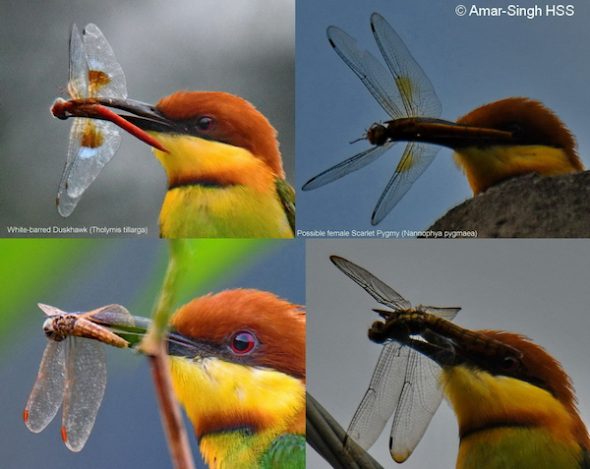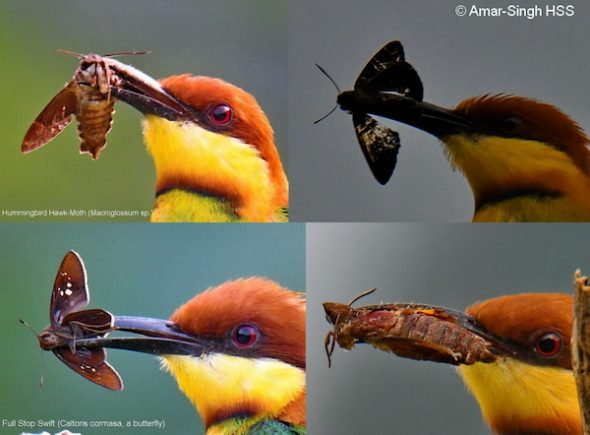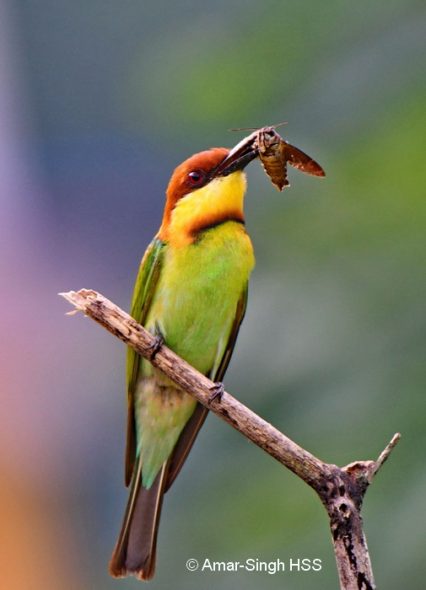Updated Disclosure on Nest Observation:
I watched 3 nests of Chestnut-headed Bee-eater (Merops leschenaulti leschenaultia) in close proximity to each other. I watched over two occasions – 15th and 18th April 2018 for 30 and 45 minutes respectively. On the first occasion I focused on social and nesting behaviour. On the second occasion I stayed 15-20 meters away at the bird’s ‘staging area’ where they stop momentarily when bringing prey to young. I monitored the bird’s distress and reluctance to feed to minimise any disruption. I avoided discovery by human passer-by’s by also focusing on other birds and the environment.
Update on Prey Brought to Young
There is limited information on prey taken by Chestnut-headed Bee-eaters (HBW 2019). Here I am documenting prey brought to young and may not reflect the typical adult diet. It is also possible that prey size and type change as the juveniles grow. All the prey brought to juveniles were insects. Although I enjoy insects, the identification of species is not easy. I have searched references and offer possible ID when I am sure but am happy if anyone has better identification for these insect prey. I was not able to observe all the prey brought to the three nests as some birds used different routes to get to the nesting holes. I imaged about 50-60% of the prey brought during the time of my observation (75 minutes over two days). I missed some of the smaller prey brought to the nests. However, these observations offer some idea of feeding behaviour of these birds. Prey was killed before offering to young, often by branch or electrical wire swiping. Prey was fed to young with wings still intact.

Composite of Chestnut-headed Bee-eaters with dragonflies.
Dragonfly prey (12 feeding episodes observed)
White-barred Duskhawk (Tholymis tillarga), male – 3
Possible Scarlet Pygmy (Nannophya pygmaea), female – 2
Libellulidae family dragonflies (called skimmers – one with a red abdomen, another with brown wings) – 2
Unidentified Dragonflies (3 species) – 4

Composite of Chestnut-headed Bee-eaters with moths and butterflies.
Moth and Butterfly Prey (8 feeding episodes observed)
Hummingbird Hawk-Moth (Macroglossum sp.) – 3
Unidentified Brown Moth – 3
Full Stop Swift (Caltoris cormasa, a butterfly) – 1
Unidentified small Butterfly – 1

Chestnut-headed Bee-eater with a White-barred Duskhawk male dragonfly (Tholymis tillarga)
Other Prey (3 feeding episodes observed)
House Fly – 1
Wasps – 2

Chestnnut-headed Bee-eater with a Hummingbird Hawk-Moth (Macroglossumsp.)
I was surprised that these birds can catch the extremely fast Hummingbird Hawk-Moths.
Amar-Singh HSS (Dato’ Dr)
Ipoh, Perak, Malaysia
Location: Ipoh, Perak, Malaysia
Habitat: Semi-Urban environment
Date: 18th April 2019
Equipment: Nikon D500 SLR with Tamron SP 150-600mm f/5-6.3 Di VC USD, handheld with Rode VideoMic Pro Plus Shotgun Microphone








